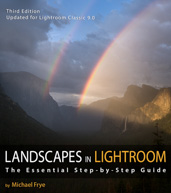In the Moment:
Michael Frye's Landscape Photography Blog
by Michael Frye | Jul 29, 2010 | Critiques
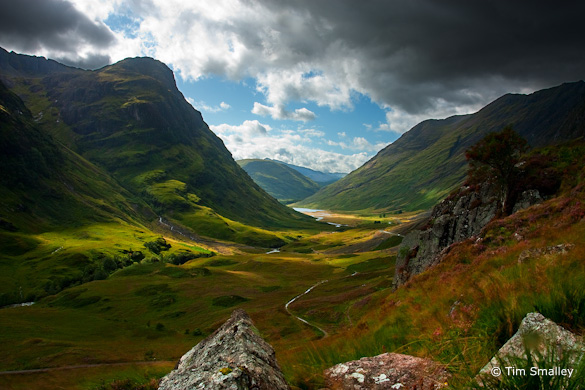
“Glen Coe” by Tim Smalley
This week’s photograph was made by Tim Smalley near Kinlochleven, Scotland. By having his image chosen for this critique Tim will receive a free 16×20 matted print from Aspen Creek Photo. If you’d like your images considered for future critiques you can upload them to the Flickr group I created for this purpose.
The first thing that grabbed me about this photograph is the wonderful light. The dappled sunshine, rich colors, and strong contrast create a powerful mood. It looks like a scene from Lord of the Rings; I could imagine winged Nazgûl swooping down over the valley.
Tim said that “There was a certain emotion that I wanted to express” about Glen Coe. “The weather is often quite mixed . . . and there can be some phenomenal light, even during the day as the sun breaks through parting clouds.” (more…)
by Michael Frye | Jul 27, 2010 | Advanced Techniques, Digital Darkroom, Video Tutorials
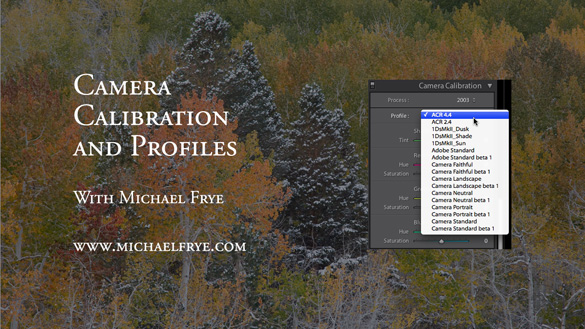
Vision is the most important part of photography. Your eye is what makes the difference between a great photograph and a mediocre one.
But when realizing your vision and making it come to life in the final image, getting the right color is vital.
Recently I posted two videos about using curves in Photoshop, Lightroom, and Camera Raw. But there’s a more fundamental step that I haven’t talked about, something you might want to do with Raw files before adding curves, correcting white balance, or doing anything else: choosing a profile.
What is a Camera Profile?
A camera profile is a translator: it’s translates the colors that a camera captures into the colors they should be. In other words, if a certain camera tends to turn reds into orange, the profile will correct for that and convert those reds back to their proper hue. Of course there’s no such thing as “correct” color—it’s all subjective. So profiles can come in different flavors: more saturated, less saturated, more contrasty, etc. Choosing the right flavor for your image is the first step toward making your visualization come to life.
I’ve posted a new video on YouTube that delves into this seemingly esoteric yet actually quite simple subject. In it I show you how to choose different profiles in Lightroom, and explore whether creating a custom profile might be worthwhile. I evaluate some profiles I made with the X-Rite ColorChecker Passport, a $99 package for making custom camera profiles in any lighting situation. Yes, full disclosure, they actually gave this to me for free—I must be hitting the big time!
Also, there’s one more reason for exploring different profile options: reducing noise, banding, and posterization. I show an example where the profile choice made a dramatic difference in noise and banding.
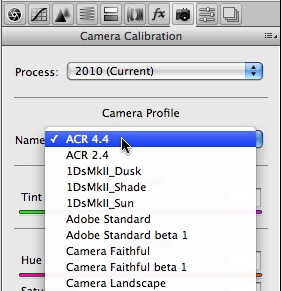
I didn’t have time to demonstrate it in the video, but the same profile choices are also available in Adobe Camera Raw—just look under the Camera Calibration tab, third from the right, as shown here.
So here’s a link to the video:
Camera Calibration and Profiles
As always, it helps to view this at the highest resolution, 480p, and click on the double-sided arrow to make the video larger.
I hope you enjoy it! Comments are always appreciated, and if you like video, please share it with a friend: Email this article, or click on one of the buttons below to post it on Facebook or Twitter.
by Michael Frye | Jul 23, 2010 | Yosemite Photo Conditions
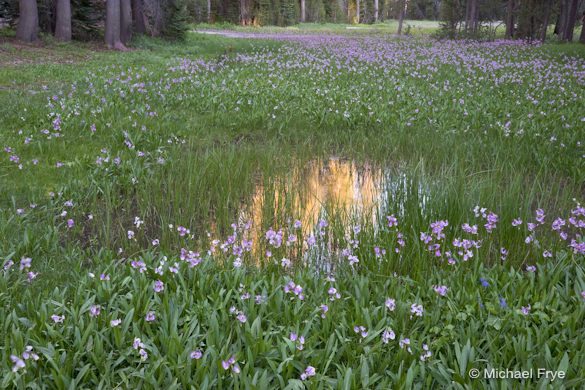
Pond and shooting stars along the Glacier Point Road
It’s late July, and spring is long gone from the Sierra foothills, where I live, and in most of California—indeed, most of the United States. But in the high elevations of the Sierra Nevada the wildflowers are just getting started. Shooting stars are abundant right now between 7000 and 9000 feet in Yosemite. I made the photograph above near the Glacier Point Road last Sunday. But shooting stars are early bloomers, and the rest of the high-country flowers are only beginning to emerge. The peak bloom at these elevations will probably arrive in early August.
Wildlfowers in August? Absolutely. Flowers bloom late in the mountains—in fact one of the best wildflower displays I’ve seen in Yosemite occurred in September after an exceptionally heavy winter.
The best places to look for flowers are often small meadows at around 7000 to 8000 feet. Many areas along the Glacier Point Road fit this description, including Summit Meadow, right next to the road, and McGurk Meadow, which requires a short hike. Naturally these areas are described in my book, the Photographer’s Guide to Yosemite—Location 21 (click here to purchase a signed copy directly from me). (more…)
by Michael Frye | Jul 15, 2010 | Critiques
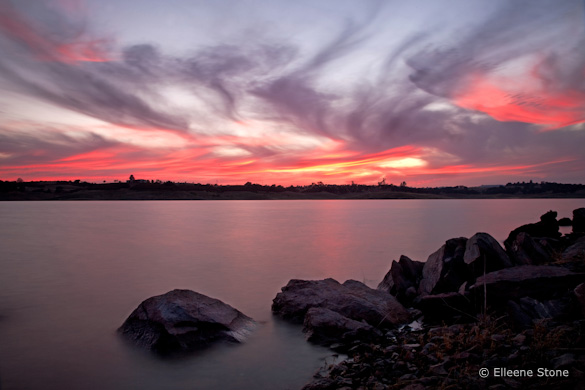
“Red Sky at Night” by Ellie Stone
This week’s photograph was made by Ellie Stone at Lake New Hogan in Calaveras County, California. By having her image chosen for this critique Ellie will receive a free 16×20 matted print from Aspen Creek Photo. If you’d like your images considered for future critiques you can upload them to theFlickr group I created for this purpose.
We’ve all seen many sunset photos. For an image like this to grab out attention it either has to portray an exceptional sunset, or somehow integrate a less-than-exceptional sunset into an unusual and striking composition.
This image certainly captured a great sunset—the color is amazing, and the wavy, zig-zagging lines of the clouds create wonderful patterns. The scene has a powerful, end-of-the-day mood. Ellie used a 15-second shutter speed to blur the choppy water—a good decision, I think, as that smoothed out the waves and added an interesting, soft texture that contrasts with the hard-edged foreground rocks.
I’m not sure, however, about the decision to include those rocks in the first place. It’s often difficult to decide whether to include a foreground or not: Does the foreground add interest to the scene, or is it an unnecessary distraction? In this case I think the sunset sky and water are enough to hold our attention. The sky, especially, is exceptional, and to me should be the focus of the composition. The rocks don’t seem as interesting.
There’s another question to ask yourself before including a foreground: Do the lines and shapes of that foreground complement the background, or clash with it? To me the lines and shapes of these foreground rocks don’t integrate particularly well with the background.
I know some books say that you should always include a foreground, middle ground, and background in landscape photographs, but I think that’s one of those arbitrary rules that should be ignored. It’s great to include all three, but only if each is adding something to the photograph. The world is infinitely varied, and no rule can encompass every situation. As Edward Weston said, “Pictures came first. Rules followed. No one ever became an artist by learning rules or keeping them.”
With that in mind, here’s a version where I’ve cropped out the foreground. The camera position forced me to eliminate most of the water along with the rocks, but since the sky is the most interesting thing in the scene, and should fill most of the frame anyway, I think the cropped version works pretty well.
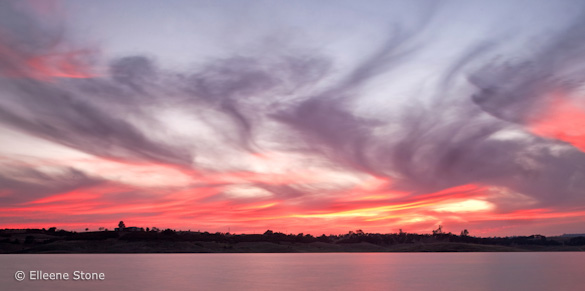
Crop A, eliminating the rocks
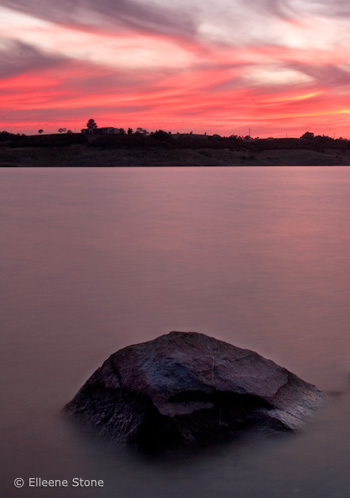 Of course if you can find a foreground that adds interest, and meshes with the background, by all means include it. While I don’t think the somewhat jumbled arrangement of rocks in the original version is appealing, there’s one, isolated rock on the left has a great shape, so I tried another crop which includes just that rock and a piece of sky. That works too: it’s simple, and the diamond shape of the rock echoes some of the diagonal lines of the clouds. But this composition emphasizes the foreground more than the sky, and with such a spectacular sunset I’m not sure that’s the right idea.
Of course if you can find a foreground that adds interest, and meshes with the background, by all means include it. While I don’t think the somewhat jumbled arrangement of rocks in the original version is appealing, there’s one, isolated rock on the left has a great shape, so I tried another crop which includes just that rock and a piece of sky. That works too: it’s simple, and the diamond shape of the rock echoes some of the diagonal lines of the clouds. But this composition emphasizes the foreground more than the sky, and with such a spectacular sunset I’m not sure that’s the right idea.
As always, I’m interested in hearing your thoughts on the foreground and the various crops presented here. Which version do you like best? Or is there some other framing that you think might be even better?
Technically this is well executed. If you’re going to include a foreground, then both foreground and background should be in focus! And they are here. The overall exposure looks right. Ellie said that she used a neutral-density filter to slow the shutter speed and blur the water’s motion, but wishes she had used a graduated filter to lighten the rocks relative to the foreground. Perhaps that might have helped, but with reflections you have to be careful not to lighten the foreground too much, as it looks unnatural when the water becomes lighter than the sky.
Despite my nitpicks about the foreground this is a very nice photograph, with great light, color, and mood, and with an effective use of a slow shutter speed to smooth the texture of the water.
Thanks Ellie for sharing your image! You can see more her work on Flickr (be sure to check out her amazing “Misty Bay Bridge” photo).
If you like these critiques, share them with a friend! Email this article, or click on one of the buttons below to post it on Facebook or Twitter.
As part of being chosen for this week’s critique Ellie will receive a free 16×20 matted print courtesy of the folks at Aspen Creek Photo. If you’d like your images considered for future critiques, just upload them to the Flickr group I created for this purpose. If you’re not a Flickr member yet, joining is free and easy. You’ll have to read and accept the rules for the group before adding images, and please, no more than five photos per person per week. I’ll be posting the next critique in two weeks. Thanks for participating!
by Michael Frye | Jul 13, 2010 | Announcements, Workshops
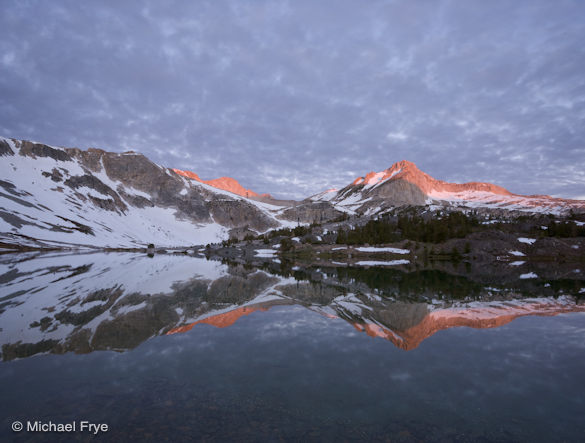
North Peak and Greenstone Lake, sunrise
I just finished teaching the Hidden Yosemite workshop for The Ansel Adams Gallery. Every year this is a really fun class, and this time was no exception. There’s something about being away from the roads that adds an extra dimension to the workshop. We had a great group, and the weather was excellent. Saturday morning at Greenstone Lake was probably the photographic highlight, with glassy water and a great mix of sun and clouds—the first time I’ve seen clouds at sunrise from this spot. The photograph above shows the first blush of light on North Peak; later, in the image below, I used a four-stop neutral-density filter, plus a polarizer, to slow the shutter speed and blur the fast-moving clouds.
We had a slide show on the last day of the workshop, and everyone in the class showed great images from Saturday morning—how could you miss with light like that? But we also saw many interesting, imaginative photographs from all the other locations we visited. It was great to see everyone’s growth over the five days of the workshop. I’ll post a link to some of the student’s photos at some point.
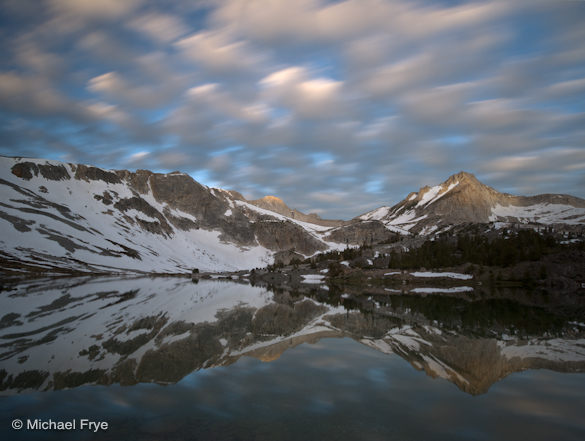
Fast-moving clouds above Greenstone Lake
by Michael Frye | Jul 6, 2010 | Advanced Techniques, Digital Darkroom, Video Tutorials
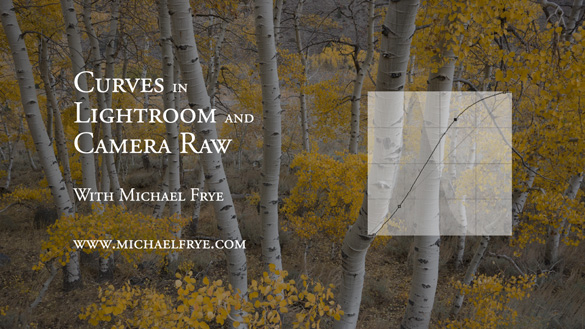
Curves in Lightroom and Camera Raw
As promised, I’ve posted another tutorial on YouTube about Curves in Lightroom and Adobe Camera Raw. In this video I examine the default settings in these applications, and why you should avoid using them—at least sometimes. These defaults actually apply three curves to your image before you even start processing it. Watch the video to see what’s really going on “under the hood” with the settings in Lightroom and Camera Raw.
Again I had to break this into two parts; here are the links:
Curves in Lightroom and Camera Raw – Part 1
Curves in Lightroom and Camera Raw – Part 2
 I hope you enjoy these—comments are always welcome! To see everything clearly you need to view in high resolution—click on where it says 240p or 360p in the lower-right corner and choose 480p. Also, if you click on the little double-sided arrow you’ll see the video larger.
I hope you enjoy these—comments are always welcome! To see everything clearly you need to view in high resolution—click on where it says 240p or 360p in the lower-right corner and choose 480p. Also, if you click on the little double-sided arrow you’ll see the video larger.
by Michael Frye | Jul 5, 2010 | Yosemite Photo Conditions
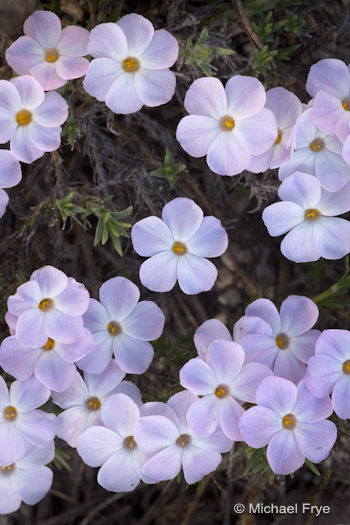 Claudia and I spent Fourth of July weekend in the Yosemite High Country, scouting for my upcomingHidden Yosemite workshop. There’s still plenty of water flowing in the creeks and rivers, and some big reflecting ponds remain in the west end of the main Tuolumne Meadow. Some flowers have appeared, like the spreading phlox shown here, penstemon along the side of the Tioga Pass Road between Yosemite Creek and Olmsted Point, and a few patches of shooting stars in damp meadows. I’m sure more flowers will be blooming soon. It promises to be a good wildflower year in the high country, but the peak probably won’t arrive until at least early August.
Claudia and I spent Fourth of July weekend in the Yosemite High Country, scouting for my upcomingHidden Yosemite workshop. There’s still plenty of water flowing in the creeks and rivers, and some big reflecting ponds remain in the west end of the main Tuolumne Meadow. Some flowers have appeared, like the spreading phlox shown here, penstemon along the side of the Tioga Pass Road between Yosemite Creek and Olmsted Point, and a few patches of shooting stars in damp meadows. I’m sure more flowers will be blooming soon. It promises to be a good wildflower year in the high country, but the peak probably won’t arrive until at least early August.
My nickname for shooting stars is “mosquito flowers,” because they grow in boggy areas and always seem to blossom at the same time as the mosquitos. Just the sight of shooting stars makes me itchy. And sure enough, the mosquitos were out, but we didn’t encounter any maddening, intolerable swarms. I’m keeping my fingers crossed, hoping that these little pests won’t be too bad this year, but it’s probably just a little too early for them at the higher elevations. But even clouds of mosquitos won’t keep me away—the high country is just too beautiful to miss.
by Michael Frye | Jul 1, 2010 | Critiques
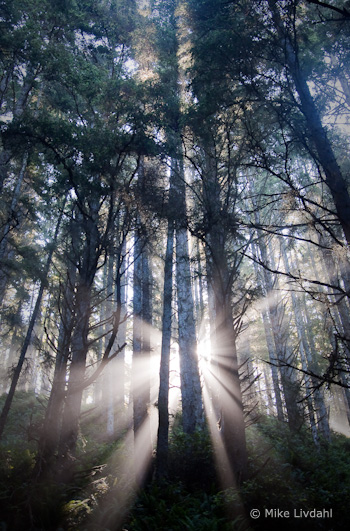
“Forest Sunrise #1 – Olympic National Park” by Mike Livdahl
This week’s photograph was made by Mike Livdahl in Olympic National Park, Washington. By having his image chosen for this critique Mike will receive a free 16×20 matted print from Aspen Creek Photo. If you’d like your images considered for future critiques you can upload them to the Flickr group I created for this purpose.
The most striking thing about this photograph is the fantastic light, with sunbeams radiating through the mist from behind tall trees. Light is the essence of photography. When we press the shutter we’re not recording objects, we’re capturing light. Often great light is enough to make a great photograph, even if the subject isn’t that interesting. These trees are nice, but without those sunbeams this would be a rather ordinary scene.
The exposure for such strong backlight can be tricky, but Mike handled it well. We see detail in all but the darkest parts of the tree trunks, yet the only the very brightest highlights are blown out. This is one of those rare instances where it’s okay to have some small washed-out areas in the photo, because this is something we would see in real life: looking at this scene the sun and adjacent sky would be blinding, and we wouldn’t expect to see detail in those areas in a photograph.
Mike said that he “exposed hoping to keep some life in the shadows.” As a result, he had to (in Lightroom) “damp the highlights pretty heavily, Recovery pushed to +81 and Brightness dropped to +29.” I guess that’s testimony to how much hidden detail can reside in seemingly overexposed highlights in Raw files. But if I were photographing this scene I’d keep my options open by bracketing exposures, allowing me to blend two or more images together later if necessary.
While the light in this photograph is exceptional, even great light could be ruined by a poor composition. Fortunately it wasn’t. The composition is clean and simple, with a strong focal point, the sunbeams, and some nice repetition created by the lines of the tree trunks. Mike chose a vertical orientation to emphasize the height of the trees. The sunbeams are centered from left to right, a configuration that works well in most vertical compositions (see my post about Sideways Photography).
That vertical orientation, however, with the sunbeams near the bottom of the frame, leaves a lot of space in the top half of the photo. The bottom part of the image is clearly the most eye-catching area, and I always think it’s best to fill the frame with the most interesting stuff. There seems to be a natural horizontal composition here, including only the areas around the sunbeams:

Alternate, horizontal crop
I think this tighter, horizontal framing has more impact, but it doesn’t convey the trees’ height, and loses some sense of place as well. So it’s a tradeoff. Which version do you prefer? Post a comment to share your thoughts on this.
Mike said that he handheld this photograph, leaning against a tree, at 1/15th sec. and 5.6 with an ISO of 400. Since this shutter speed resulted in a slightly soft photo, he added extra sharpening in Lightroom. In a larger view some of the closest branches are a bit soft, indicating that the wide f/5.6 aperture wasn’t enough to keep everything in focus. Obviously a tripod would have been a good idea here—it would have prevented camera movement while allowing a smaller aperture with more depth of field.
The post-processing looks well done; the white balance looks right, and the heavy use of the Recovery tool created a perfect range of contrast—small areas of black, small areas of white, with a full range of tones in between.
Overall this is well done—beautiful light composed well.
Thanks Mike for sharing your image! You can see more his work on Flickr.
If you like these critiques, share them with a friend! Email this article, or click on one of the buttons below to post it on Facebook or Twitter.
As part of being chosen for this week’s critique Mike will receive a free 16×20 matted print courtesy of the folks at Aspen Creek Photo. If you’d like your images considered for future critiques, just upload them to the Flickr group I created for this purpose. If you’re not a Flickr member yet, joining is free and easy. You’ll have to read and accept the rules for the group before adding images, and please, no more than five photos per person per week. I’ll be posting the next critique in two weeks. Thanks for participating!
by Michael Frye | Jun 24, 2010 | Advanced Techniques, Digital Darkroom, Video Tutorials
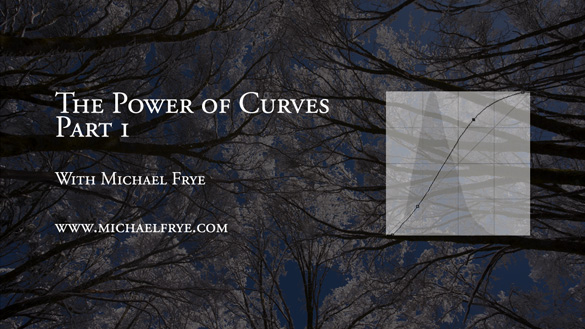
I did something I’ve wanted to do for a long time: post a video tutorial on YouTube. It’s called The Power of Curves, and it’s about, well, curves in Photoshop. This is one of those things that’s just easier to show than explain, so it’s a perfect subject for video.
I think Curves are the single most powerful tool in the digital darkroom; if you learn to master Curves, you’re well on your way to mastering image-processing. Curves tend to intimidate some people, as they seem foreign if you haven’t used them before. But Curves are really quite simple, and I hope this video helps clarify how to use this amazing tool. I had to break this into two parts; here are the links:
The Power of Curves Part 1
The Power of Curves Part 2
Originally I had wanted to talk about the new Point Curve feature in Lightroom 3, but then realized that I needed to explain some basics about Curves first, and that Photoshop was a better tool for that. But I’ll post another video in about two weeks about using Curves in Lightroom and Adobe Camera Raw, and about dealing with their strange default settings.
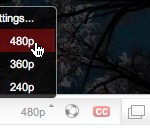 So I hope you enjoy these—let me know what you think! To see everything clearly you need to view in high resolution—click on where it says 240p or 360p in the lower-right corner and choose 480p. Also, if you click on the little double-sided arrow you’ll see the video larger.
So I hope you enjoy these—let me know what you think! To see everything clearly you need to view in high resolution—click on where it says 240p or 360p in the lower-right corner and choose 480p. Also, if you click on the little double-sided arrow you’ll see the video larger.
by Michael Frye | Jun 21, 2010 | Yosemite Photo Conditions
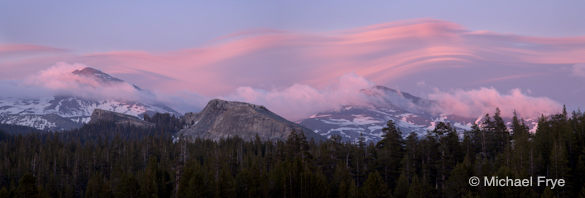
Lenticular cloud above Mounts Dana and Gibbs
Saturday Claudia and I drove up to Tuolumne Meadows. There was still lots of snow in the high country—not as much as when the pass first opened, of course, but plenty. We hiked around Pothole Dome to the place where the Tuolumne River starts to tumble down from the west end of the meadows, as I wanted to photograph these cascades with high water. We had the place to ourselves and it was beautiful. Claudia took a short video of that upper cascade, which I posted on Facebook.
We kept our eyes on a big lenticular cloud that had formed over the mountains to the north, but it seemed to dissipate near the end of the day. As we walked back up to the main meadow near sunset, however, we saw that a smaller lenticular cloud was riding above Mt. Gibbs, so we rushed to a spot closer to the road and caught the last sunset light on the mountains. I assembled the panorama above from two images zoomed in on the peaks.
We didn’t get home until 11 p.m., but it was worth it. We had a great afternoon in a special place.
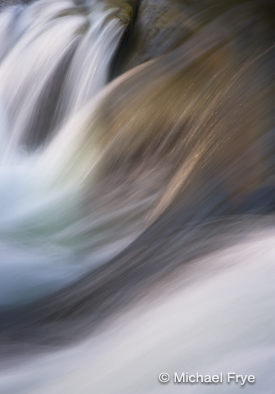
Water leaving Tuolumne Meadows (this is the cascade in the video)

























